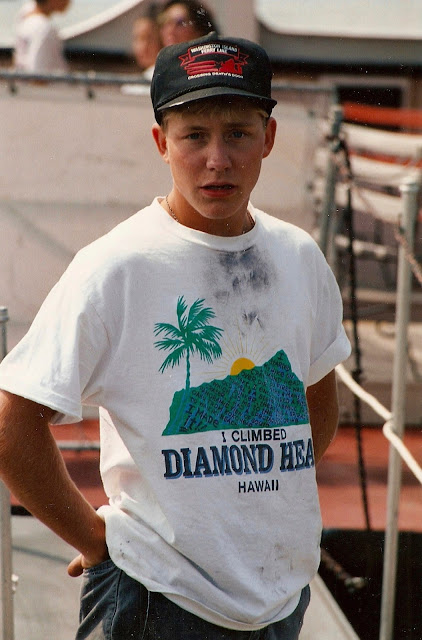 |
Fall weather at its best, with wind gusts topping 40 mph,
Thursday, Nov. 19. Eric Foss guided the Robert Noble
through 6-8 ft. swells. A rare cancellation was made
for the last trip of the day, with darkness adding to
operational challenges. |
Washington Island, Wisconsin -
Erik Foss reminded me a week or two ago, as I drove onboard the Washington for a trip down the peninsula, that my last blog was posted in late September, the equivalent of internet eons ago. Such a deterioration in communications.
So I'd better get with the program.
If you happened to watch Channel 5 weather at the 6:00 pm and 10:00 pm on Nov. 12th, you may have seen the ferry
Washington lurching through seas in the Door. Erik Foss happened to be at the wheel, and he was comfortable enough on camera to crack a joke with the reporter, a reference I was unable to hear. Nearly all ferry trips are made without television crews along for the ride. Their film, however, showed a more realistic look at ferry travel to and from Washington Island, at least in the fall. And, in more recent days the conditions were far windier.
But overall the 2015 Fall season was mild with moderate wind conditions, and the fall colors held on well into October with plenty of unexpected, bonus days that enabled us to accomplish outdoor activities. In addition to picking up fallen leaves, many of my outdoor hours were spent glazing windows and touching up the paint on old buildings. Unless it warms up again, I'll move on to brushing and woodcutting for a few weeks, before the snow and consistently colder temperatures stay with us.
This morning, following a light rain most of Thanksgiving day, we awoke to a light cover of snow on the ground. The thermometer hasn't budged off the 30-degree mark.
* * * * *
Jim Rose sent along photos of an improvement for the Percy Johnson County Park (formerly, Eastside Park.) The transportation of this modern day outhouse to the Island was shipped on two separate semi trucks, along with a large, portable crane to lift and set each section.
This dandy crapper came in ready-to-assemble sections: the upper structure for above-ground, walk-in patrons, and the vault for below ground waste storage. Wonder what Percy would think about the improvement, in particular the cost?
In the interest of a more complete story, I need to take a photo of the finished product, learn where it was manufactured, approximate cost, and its success as a public improvement.
* * * *
Thanksgiving blessings
With Thanksgiving leftovers still on hand, and appreciation for the bounty so many of us enjoy in terms of food, shelter and the essentials of life, I'm also reminded of the different approaches individuals choose to take.
Back in mid-September (while waiting in line for an order at the Albatross) I had a conversation about the seemingly late turn of colors, and of the eventual coming of winter.
"It might be warm now, but just wait," the man said. "If you watch squirrel activity, they've been quite busy lately, and that's a sign it's going to be a hard winter."
I've heard it said before by old timers (Jack Hagen, among others) that squirrel activity is an indicator of the severity of winter to come. (It could also have to do with the abundance of acorns produced in a particular year that spurs such activity, not unlike shoppers scurrying after bargains on the day following Thanksgiving.) The gist of the old adage is, we can learn from observing squirrels, that they sense things we don't.
Earlier this fall, we observed squirrel-like human activity, too, the storing away of tons of canned food, dry goods, and essentials tools and equipment.
Was this storing of "nuts" the conscious preparation for an impending disaster that regionally and nationally might cripple communications, supply lines, transportation routes and electric grids?
Almost everything we use depends upon electronics that are susceptible to hacking and interruption, whether by villainous perpetrators or natural causes. A major disaster would make such private storehouses of goods an essential element for survival of the few who have the foresight, wealth and gumption to see into and prepare for the future, so the logic goes.
This way of thinking - to my mind negative, and almost nutty - me wonder if the rest of us are just naive to forces beyond our shores? Those who properly prepare, as I understand it, are people who act on knowledge and a healthy fear of things to come by laying in supplies for the impending disaster.
As I was about to dismiss the notion to follow the lead of squirrels, I read a short piece in an AARP magazine (that's right, my undisputed source of information!) where television journalist Ted Koppel was interviewed regarding his theories of what might happen if the nation's electric grid goes down. Less than a week later, I listened to Koppel on the CBS Sunday Morning program as he elaborated on his investigations. As he sees it, a major electrical grid failure is inevitable, just a matter of when, a belief he outlines in his book,
Lights Out! No one in government is prepared, or looking out for our interests in such a scenario, according to Koppel.
Then, I read a piece in the October 26 issue of
The Waterways Journal, a weekly magazine of maritime trade and transportation on North America's inland waterways:
Navy To Reinstate Celestial Navigation
After an absence of nine years from the curriculum of the Unites States Naval Academy at Annapolis and a 15-year absence from Naval ROTC programs, U.S. naval officers are once again learning to navigate by the stars, the Navy announced.
The class of 2017 will be the first in many years to graduate with a basic knowledge of celestial navigation.
This article went on to announce that the U. S. Navy was reintroducing sextant skills to its cadets, due to the increased concerns about the vulnerability to errors and possible hacking of government high-tech instruments and satellites. It was also possible, it was noted, that during a national emergency our government might elect to shut down the GPS system, because it might be used to advantage by potential enemies.
This information was, again, something I hadn't considered. I agree there are real benefits for teaching celestial navigation as a back-up to electronics (as was the practice for a number of decades), and I hadn't even realized that celestial navigational had been dropped from the curriculum for future Naval officers.
When adding these various things up, a conscientious squirrel begins to wonder if we're far enough out of the mainstream of life to ignore the signs? Will our household in a disaster fail to provide health and happiness? Should we continue in belief in the American system, as we've known it?
Surely there are thousands of brilliant people who. through their concern for prosperity and survival, have given a great deal of thought to the consequences? If so, we're in good company continuing along our path of "productive citizenship." Projects, contracts, planning and financing for the future … continues apace in all manner of scale, nationally and globally. Preparing for an eventuality that may never come is a risk analysis of the highest order. It can seem silly, like the practice of ducking beneath classroom desks in the late 50s to avoid nuclear annihilation.
It's been suggested to me that what others do is none of my business, that one can spend hard-earned income however he or she wishes, even if that wish is to stockpile the goods of this earth to extend our days. Maybe they're right. I shouldn't puzzle over the lives and decisions of those I can't understand.
But, another question bothers me: How will those individuals during a major disaster - the ones with foresight and capital to cache food and supplies: a) Hold off friends, neighbors and relatives at gunpoint when desperation sets in; or, b) Share food and supplies equitably with those same neighbors, friends or relatives, thereby limiting their own longevity?
We might take action from another observation in nature. Every so often squirrels are observed jumping into the lake and swimming away from shore, perhaps when populations exceed nut supply.
Should we follow one another, like squirrels over the edge of the bluff, or continue to stand on firm ground, building on the foundations laid before us? Do we allow squirrel observations to rule our lives?
- Dick Purinton





































